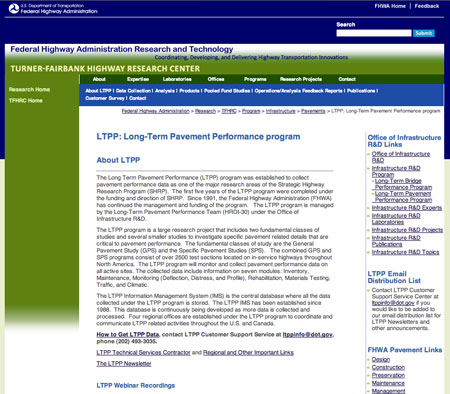U.S. Department of Transportation
Federal Highway Administration
1200 New Jersey Avenue, SE
Washington, DC 20590
202-366-4000
Focus
| Accelerating Infrastructure Innovations |
Publication Number: FHWA-HRT-13-013
Date: May 2013
Printable Version (.pdf, 0.4 mb)
New software available for beta testing from the Federal Highway Administration's (FHWA) Long-Term Pavement Performance (LTPP) program is helping transportation agencies plug their traffic loading data gaps when designing pavements.
FHWA developed the LTPP-PLUG (Pavement Loading User Guide) software to assist agencies in selecting axle loading defaults to use with the Mechanistic-Empirical Pavement Design Guide (MEPDG). These defaults can be used for pavement sites where site-specific traffic data collected by weigh-in-motion (WIM) equipment are limited or do not exist.
Available as a Microsoft Access® database application, LTPP-PLUG works with both LTPP and user-provided WIM data summaries to produce axle load distribution files. These files can be used with the MEPDG and its related software products. The LTPP WIM data describes the range of axle loading conditions observed at select Specific Pavement Study (SPS) sites of the LTPP program.
"LTPP-PLUG gives you the flexibility to pick what's best for you. Designed to be easy to use by pavement engineers, it lets you use either global defaults or targeted defaults based on your own data," said Mark Hallenbeck of the Washington State Transportation Center. "The resulting file then becomes an input to the MEPDG." The program can meet the needs of both pavement engineers that have little background in traffic data and staff more experienced in working with such data.
Agencies can compare their own data to the LTPP axle loading defaults and decide which is better to use. Users also have the option of being guided through the selection process. The LTPP loading defaults are divided into two tiers. Tier 1 represents a national default, or the average loading condition from LTPP SPS sites for each type of axle for every class of vehicle. Tier 2 groups these data into different loading conditions, ranging from very light to very heavy axle load distributions. Also built into the LTPP-PLUG software is a mechanism for grouping axle loading distributions supplied independently by State highway agencies and then computing State-specific axle loading defaults.
To receive a free copy of LTPP-PLUG for beta testing, send an email to LTPPinfo@dot.gov. Beta testing will continue until June 14, 2013. To download the recorded presentations from a February FHWA Webinar that featured LTPP-PLUG, visit www.fhwa.dot.gov/research/tfhrc/programs/infrastructure/pavements/ltpp. For more information, contact Deborah Walker at FHWA, 202-493-3068 (email: deborah.walker@dot.gov).

For more information about LTPP-PLUG and other resources available from the Long-Term Pavement Performance program, visit www.fhwa.dot.gov/research/tfhrc/programs/infrastructure/pavements/ltpp.